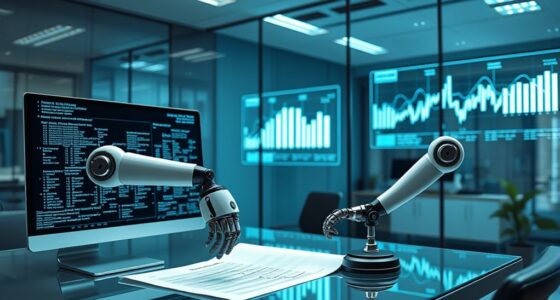Jobs involving routine tasks are most likely to be automated soon. In administration, scheduling, billing, and paperwork are at risk, while manufacturing roles like assembly and quality control are increasingly replaced by robots. Retail, healthcare, and technology sectors are also automating customer support, diagnostics, and software development. If you want to see which specific roles are next and how to prepare, keep exploring these sector-by-sector forecasts.
Key Takeaways
- Administrative roles, especially routine tasks like data entry and scheduling, are increasingly automated across healthcare, finance, and government sectors.
- Manufacturing and warehouse jobs involving assembly and inventory management are being replaced by robots and automated guided vehicles.
- Retail positions focused on checkout, inventory, and customer support are transforming with AI, robotics, and blockchain technology.
- Routine coding and application development tasks in the tech industry are highly susceptible to automation through low-code platforms and AI tools.
- Energy, utilities, and mining roles centered on monitoring and data collection are vulnerable to IoT, predictive analytics, and robotic automation.
Administrative Jobs Facing Automation

Are administrative jobs truly on the brink of widespread automation? The answer is a strong yes. Over 40% of administrative roles globally may be automated within the next five years. Already, more than a third of your routine tasks, like data entry and scheduling, are handled by machines. AI tools now manage emails, process documents, and coordinate calendars, reducing manual effort. By 2025, 70% of organizations plan to adopt structured automation, up from 20% in 2021. As a result, your job could shift toward supervising AI systems or handling complex tasks that machines can’t yet manage. Widespread automation could affect 1.2 billion employees, opening opportunities for new skills and hybrid work models. Preparing for these changes can help you stay relevant in a rapidly evolving workplace.
Manufacturing Roles That May Disappear

Robotics are replacing many manual manufacturing jobs, making some roles obsolete. As automation grows, workers face skills shift challenges to stay relevant. You’ll need to adapt quickly to new technologies or risk being left behind. Automation adoption rates are accelerating across manufacturing, highlighting the importance of continuous learning and the need to understand advanced manufacturing technologies. Recognizing the role of human oversight remains critical, as some tasks still require human judgment and flexibility. Additionally, the integration of waterpark-themed entertainment in some manufacturing sectors exemplifies innovative approaches to workforce engagement and safety. Staying informed about preppy dog names can provide insights into branding and marketing trends within various industries. Furthermore, understanding reviews of educational toys can help industries develop products that support skill development and safety standards.
Robotics Replacing Workers
As automation continues to advance in manufacturing, many workers find their roles increasingly vulnerable to replacement by robots. The impact is significant, with around 1.7 million manufacturing jobs lost to automation. You should note that:
- Production line workers are most affected, as robots handle assembly and packaging tasks efficiently. The integration of robotic systems has led to more seamless production processes.
- Quality control roles are being automated with sensors and AI monitoring product quality.
- Machine maintenance is increasingly performed by autonomous systems, reducing human intervention. Incorporating predictive maintenance has minimized downtime and optimized operational efficiency.
- Assembly line jobs are disappearing as robots perform repetitive tasks with speed and precision. Automation technology has become more sophisticated, enabling machines to perform complex tasks previously done by humans.
- The adoption of smart manufacturing technologies has accelerated significantly, supporting these automation trends. The use of advanced sensors and AI-driven analytics further enhances the capabilities of automated systems.
Skills Transition Challenges
The rapid growth of automation in manufacturing presents significant challenges for workers trying to adapt their skills. You may face the need to learn new competencies like AI training, data analysis, cybersecurity, and digital literacy. These shifts require time and resources, and training costs can be high. Many employees might experience a skills gap, making it difficult to shift smoothly into emerging roles like automation engineers, data scientists, or cybersecurity specialists. Additionally, the pace of technological change can leave workers feeling overwhelmed, especially if they lack access to ongoing education. You’ll need to stay proactive, seeking training opportunities to remain relevant. Overcoming these skills change challenges is vital to avoid job displacement and thrive in the evolving manufacturing landscape. The industry is actively developing new training programs to help workers transition more effectively, including upskilling initiatives that focus on emerging technological skills. Developing a comprehensive understanding of digital tools will be essential for future success in manufacturing careers. Building familiarity with dreaming techniques can also enhance problem-solving and creativity in adapting to new technological environments. Furthermore, embracing STEM education can provide workers with foundational skills necessary for the jobs of the future. Recognizing the importance of digital literacy can further empower workers to navigate the technological demands of modern manufacturing.
The Future of Retail Workforce Automation
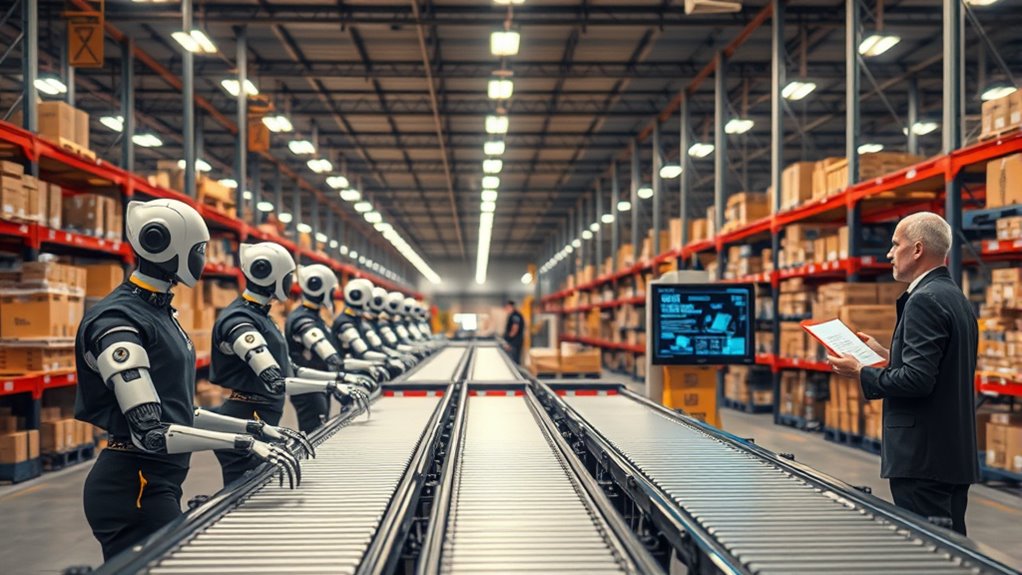
Advancements in retail automation are transforming the workforce landscape, leading to both job displacement and new opportunities. As the market grows, automation technologies like AI, robotics, and blockchain are increasingly integrated into store operations. You’ll see shifts in roles such as cashiers and inventory managers, but also the emergence of jobs in AI development and system maintenance. To adapt, focus on: 1. Embracing retraining in automation and tech skills. 2. Developing expertise in AI and robotics applications. 3. Staying informed about evolving store technologies. 4. Leveraging new roles created by automation, like system analysts or automation specialists. Imagination can play a vital role in envisioning innovative solutions to adapt to these technological changes. Additionally, understanding Catering and Delivery trends, such as the rise of mobile apps and health-conscious options, can inspire new automation opportunities in retail contexts. The retail automation market is expected to reach USD 56.12 billion by 2032, highlighting the rapid adoption of these technologies. Automation aims to enhance operational efficiency and customer experience, but it also demands workforce adaptation. Incorporating creative problem-solving can help develop unique approaches to overcoming workforce challenges posed by automation. Moreover, integrating Natural Language Processing (NLP) into customer service systems can further improve engagement and satisfaction. The future of retail automation is about balancing job displacement with opportunities for growth and innovation. Furthermore, implementing training programs that focus on both technical skills and customer service can help the workforce transition smoothly.
AI’s Impact on Healthcare Positions
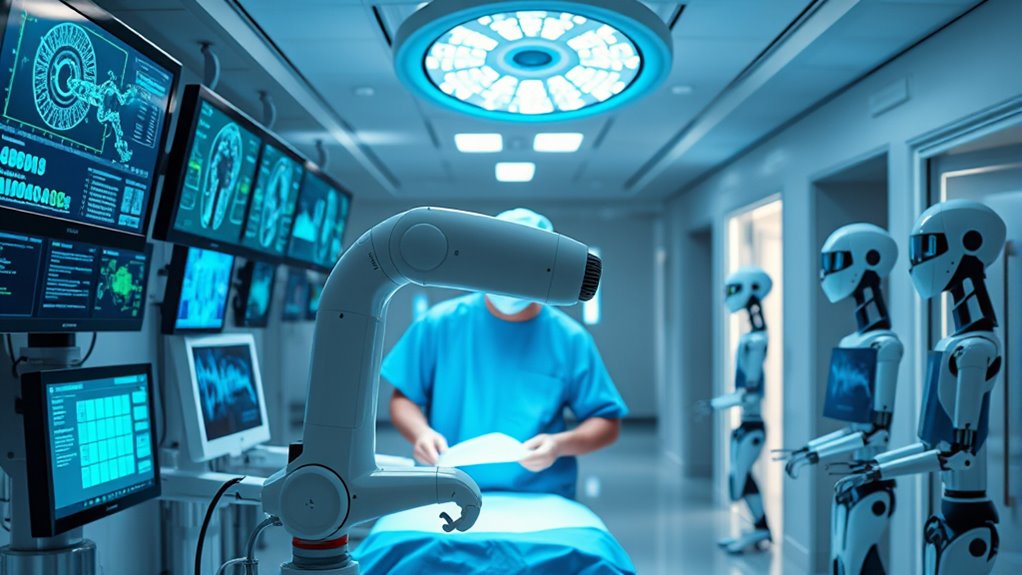
AI is transforming healthcare positions by streamlining workflows and enhancing diagnostic accuracy. You’ll notice that 86% of healthcare organizations are already using AI extensively, with hospitals expected to rely on it for early diagnosis and remote monitoring by 2025. Doctors see AI impacting employment, especially in surgical specialties. Administrative tasks are growing more efficient, reducing physicians’ time spent on paperwork by about 20%. Pathologists and other specialists expect AI to assist in analyzing patient data, improving prognoses, and guiding treatment referrals. While AI enhances clinical documentation and reduces bias, most nursing tasks will still be performed by humans through 2030. Overall, AI offers opportunities to improve patient outcomes and operational efficiency, but it also raises questions about professional liability and the provider-patient relationship.
Technology Sector: Automation and Opportunities
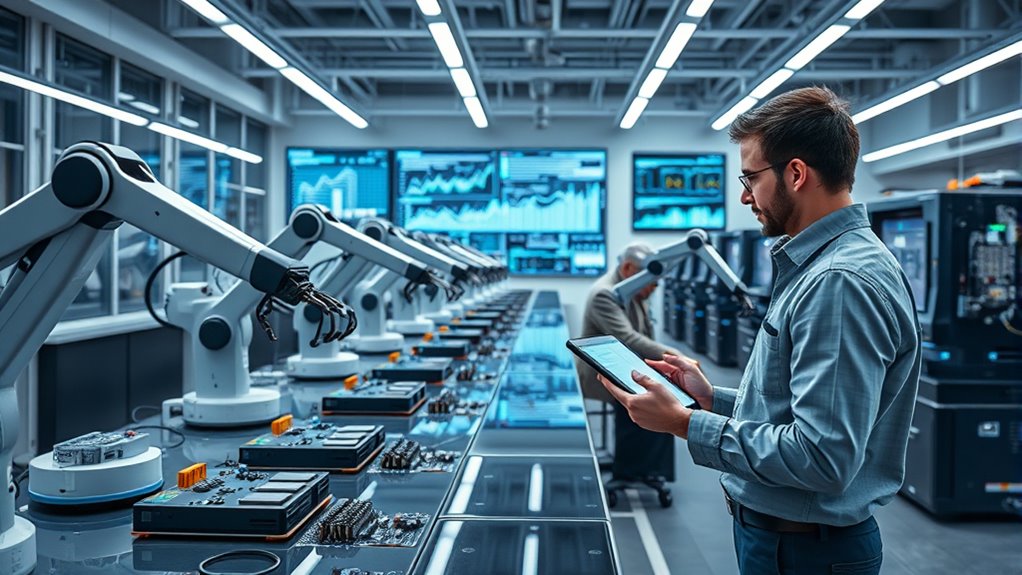
As automation takes over routine coding tasks, you’ll find more opportunities for specialized roles like AI experts and automation strategists. To stay competitive, you need to develop new skills in AI, machine learning, and cloud technologies. Embracing these changes can open doors to innovative positions that reshape the tech landscape. Global IT spending is projected to grow 9.3% in 2025, signaling significant investment in advanced technologies and talent development.
Routine Coding Automation
Have you noticed how routine coding tasks are increasingly being automated across the tech industry? This shift is driven by the rise of low-code/no-code platforms, which are projected to handle 75% of application development by 2025. Additionally, AI-driven automation fuels rapid growth in RPA, expected to reach $600 billion by 2025. As automation spreads, you’ll see:
- Repetitive coding tasks reduced by 60–95%
- 94% of organizations tackling time-consuming, automatable tasks
- 66% of knowledge workers experiencing productivity gains
- A growing need for professionals skilled in automation integration and troubleshooting
These trends mean fewer routine jobs, more focus on oversight, and new opportunities for those adapting to automation-driven workflows. Staying current is essential to thrive in this evolving landscape.
Rise of AI Specialists
The rise of AI specialists is transforming the technology sector, driven by increasing demand for advanced AI skills across industries. You’ll notice AI job postings now make up over 9.5% of all software development roles, reflecting widespread adoption. New roles like Generative AI Engineer and Computer Vision Engineer show deepening specialization. AI technologies are creating new jobs by automating routine tasks and requiring specific expertise. Major companies, including banks, have boosted their AI teams by 13% in just six months, highlighting broader industry commitment. As AI systems become integral to daily operations, the need for skilled AI professionals grows. This shift is opening opportunities for those with AI fluency, technical skills, and adaptability, shaping the future of tech careers and industry innovation.
Evolving Tech Skills
Advancements in AI specialization are reshaping the skills needed across the tech sector, particularly as automation becomes more sophisticated and widespread. To stay relevant, you need to develop a mix of technical and adaptive skills. Here are key areas to focus on:
- Plug & Produce Solutions: Master implementations that enable quick deployment and scalability, especially for small and medium-sized businesses.
- Generative AI & NLP: Learn how AI generates data, processes language, and enhances human-machine interaction.
- Intelligent Document Processing: Gain skills in automating document workflows with AI for faster, more accurate results.
- Emotional Intelligence in AI: Develop understanding of how AI interprets and responds to human emotions, essential for customer-centered roles.
These evolving skills *open* new opportunities as automation advances.
Energy, Utilities, and Mining: Automation Risks

As automation accelerates in energy, utilities, and mining, companies face significant risks alongside potential gains. You could see routine tasks like meter data collection, billing, and equipment monitoring replaced by AI and robotic process automation. Predictive analytics and IoT sensors improve efficiency but threaten jobs involving manual oversight. Automated grid management and supply chain systems boost productivity and cut costs but may lead to job displacement in roles tied to operational monitoring and compliance reporting. While these technologies enhance reliability and reduce outages, the reliance on digital infrastructure introduces cybersecurity vulnerabilities. Balancing automation benefits with workforce impacts remains a challenge. If not managed carefully, you risk losing essential manual roles and facing increased dependence on data quality and integration of legacy systems.
Tasks Most Vulnerable to Automation Across Sectors
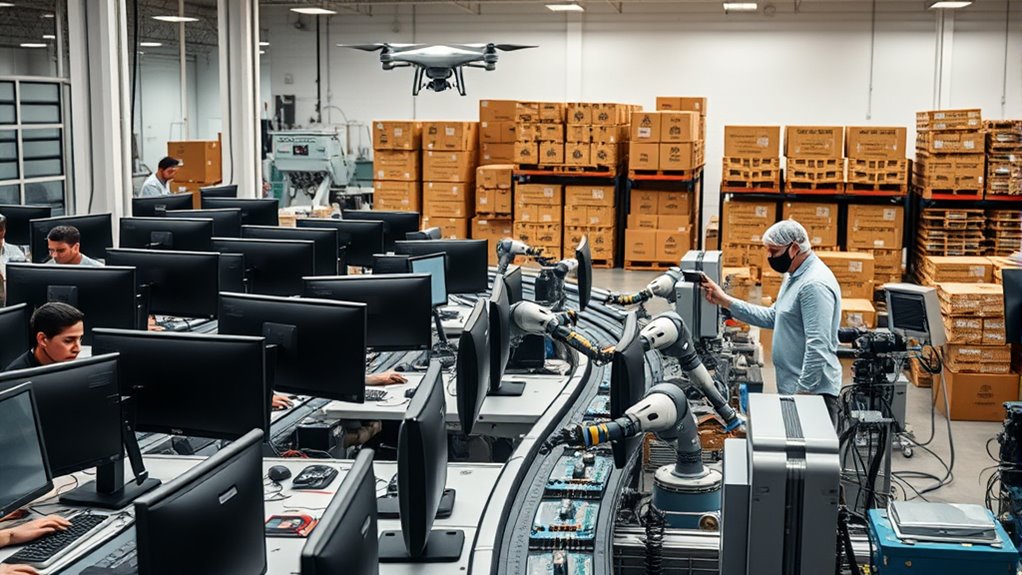
You’ll notice that repetitive data entry and processing tasks are among the first to be automated because machines can handle large volumes faster and more accurately. Routine diagnostic work in sectors like manufacturing and healthcare also face high automation risks, as robots and AI improve efficiency. Manual manufacturing operations are increasingly replaced by robotics, making many routine tasks obsolete.
Repetitive Data Entry
Have you ever wondered how much of your daily work involves repetitive data entry? It’s more than you might think. Typically, office workers spend around 10% of their time manually entering data into systems like ERP, CRM, or spreadsheets. Over half of your workday could be spent creating or updating documents such as PDFs or Word files. Specifically:
- 51% of employees spend at least two hours daily on repetitive tasks.
- Much of this time is dedicated to data entry.
- Repetitive data entry exists across sectors like healthcare, banking, and insurance.
- Monotonous manual duties still dominate many digital workplaces.
Automation is rapidly changing this landscape, with over 7.5 million data entry jobs predicted to disappear in the next five years.
Routine Diagnostic Tasks
Routine diagnostic tasks across sectors are increasingly vulnerable to automation, driven by advances in AI and machine learning. In laboratories, AI automates routine procedures, boosting precision and reducing manual labor. Diagnostic accuracy improves as AI quickly analyzes vast data sets, helping identify issues faster. Predictive analytics allow machine learning models to forecast disease progression, enabling earlier interventions. Integration with lab systems streamlines workflows, delivering results more rapidly. In healthcare, AI’s role in digital pathology and diagnostic imaging is expanding, analyzing images and detecting subtle patterns that humans might miss. Automation reduces workload, accelerates data processing, and enhances collaboration among professionals. Despite regulatory hurdles, these technological advancements are transforming diagnostic workflows, making them more efficient, accurate, and patient-centric, with AI poised to shape the future of diagnostics.
Manual Manufacturing Operations
Automation is rapidly reshaping manual manufacturing operations across various sectors by replacing repetitive, standardized tasks with robotic and digital systems. Tasks like assembly, material handling, machine operation, and inspection are highly vulnerable. Consider these points:
- Up to 749 billion work hours could be saved by automating 64% of manufacturing tasks globally.
- Routine manual assembly and inspection are prime targets, with robots automating 42% of production tasks by 2023.
- Automated guided vehicles and drones are replacing manual warehouse tasks, addressing labor shortages.
- Automation boosts productivity by about 1.4% annually, improves product quality, and cuts costs.
If you’re involved in manufacturing, expect these changes to streamline operations, reduce manual effort, and reshape job roles markedly.
Skills Needed for the Automated Workplace

To thrive in the increasingly automated workplace, you need a blend of technical skills, adaptability, and soft skills. A solid understanding of AI tools and machine learning is essential, especially for roles like data analysts and developers. Building data literacy helps you collaborate effectively with AI, improving decision-making. Continuous learning is vital—staying current with AI advancements and engaging in targeted training like workshops keeps your skills sharp. Flexibility and resilience enable you to adapt to rapid technological changes, while creativity and innovation help you leverage AI for faster problem-solving and new ideas. Critical thinking allows you to interpret AI outputs and make informed decisions. Finally, emotional intelligence and strong communication skills foster collaboration and help you lead teams through technological shifts confidently.
Human Oversight in an Automated World

In an increasingly automated workplace, human oversight remains essential to guarantee AI-driven decisions align with organizational values, ethical standards, and cultural nuances. Without this oversight, AI can undermine intuitive judgment, trust, and fairness. To assure effective management, consider these key points:
- Human judgment is crucial for balancing AI insights with ethical and cultural considerations.
- Transparency and accuracy in AI predictions build trust and facilitate adoption.
- Leaders need training to interpret AI recommendations properly.
- Oversight helps navigate ethical dilemmas AI cannot understand, especially in sensitive areas like healthcare or finance.
Legislative efforts like the “No Robo Bosses Act” reinforce the importance of maintaining human control. Ultimately, human oversight safeguards ethical standards and aligns AI actions with core organizational principles.
Preparing for Job Transitions in Various Industries

As workplaces become more automated, preparing for changes in employment across industries is more important than ever. You need to understand which sectors are most vulnerable and develop strategies to adapt. For example, manufacturing faces a 60% risk of job loss due to robotics, while retail has 70% of jobs exposed to automation through e-commerce and self-service options. In healthcare administration, AI can handle scheduling and billing, reducing administrative roles. Transportation may see autonomous vehicles replacing human drivers, and data entry jobs could disappear as AI automates repetitive tasks. To stay relevant, focus on building skills like digital literacy, data analysis, creative problem-solving, and adaptability. Companies and governments are investing in upskilling and retraining programs to ease transitions and prepare you for the evolving job market.
Frequently Asked Questions
Which New Jobs Will AI Create Across Different Sectors?
You’ll find that AI is creating new jobs across various sectors. In manufacturing, you might become a robotics engineer or AI maintenance specialist. Healthcare needs data analysts and AI diagnosis experts. Education will offer roles like content creators and platform developers. The tech industry will hire AI researchers, developers, and ethicists. Embracing these changes means developing skills in AI programming, data analysis, and digital literacy to stay ahead in the evolving job market.
How Can Workers Effectively Reskill for Automation-Driven Industries?
Think of reskilling as upgrading your toolkit; just like a mechanic learns new tools, you need digital literacy, data analysis, and AI skills. To stay ahead, take online courses, join upskilling programs, or find mentors. Remember, 14% of workers face displacement, so proactive learning can turn challenges into opportunities. Embrace continuous learning and industry partnerships to navigate industry shifts confidently and secure your future in automation-driven industries.
What Ethical Considerations Arise With Widespread Automation?
You should consider the ethical issues that come with widespread automation, like fairness, privacy, and accountability. As automation widens gaps and impacts communities, you need to prioritize supporting displaced workers through retraining and social programs. Ensuring transparency in AI use, protecting personal data, and promoting inclusive policies help prevent inequality and promote trust. Ultimately, you play a role in advocating for responsible automation that benefits everyone, not just corporations.
How Do Small Businesses Adapt to Increasing Automation Trends?
Imagine riding a wave of change; you adapt by embracing automation to stay afloat. You streamline processes with tools like workflow management and social media automation, saving time and reducing errors. To succeed, you invest in employee training, prioritize data security, and monitor systems regularly. This way, you grow efficiently, enhance customer experiences, and keep your small business competitive in an evolving landscape.
What Role Will Government Policies Play in Workforce Automation?
You’ll find government policies playing a vital role in workforce automation by shaping training programs, funding initiatives, and regulations. They aim to close skills gaps, support workers through rapid response services, and modernize workforce development. With a focus on data standards and cybersecurity, policies facilitate a smooth transition, helping you stay adaptable and competitive as automation transforms industries. Your success depends on how well these policies prepare you for future workforce changes.
Conclusion
So, as you watch jobs disappear faster than your favorite app updates, remember—automation promises efficiency, but at what cost? You might find yourself grateful for those irreplaceable human skills, or maybe you’ll just enjoy the irony of working alongside machines that never call in sick. Either way, staying adaptable isn’t optional anymore. Embrace the change, because the future’s here—ready or not—and it’s probably more automated than you think.


